Key Challenges and Potential Opportunities in Water Management Crises: The Case of the Rio Turbio Basin in Mexico
Abstract
1. Introduction
1.1. Literature Review
1.1.1. Water Management in the Río Turbio Basin
1.1.2. Institutional Framework and Governance Challenges in the Río Turbio Basin
1.1.3. The Role of Actors in Water Management
1.1.4. Toward Integrated and Sustainable Water Management
2. Materials and Methods
2.1. Literature Review
- “water management” AND “Mexico” AND “Bajío region”;
- “Río Turbio Basin” AND “groundwater depletion”;
- “industrial pollution” AND “León leather industry” AND “water governance”;
- “climate change” AND “water scarcity” AND “aquifer over-extraction”;
- “institutional fragmentation” AND “water policy” AND “governance challenges”.
2.2. Case Study
2.3. Semi-Directed Interviews
- Climate Change: Participants discussed the exacerbation of water scarcity due to changing weather patterns, prolonged droughts, and extreme events.
- Social Terms: Interviewees addressed issues of inequity in water allocation, and the impacts on local communities were central topics.
- Economic Factors: The economic implications of water shortages, particularly for agriculture and industry, were examined.
- Environmental Impacts: Experts highlighted ecosystem degradation, biodiversity loss, and pollution as pressing concerns.
- Institutional Challenges: Weak regulatory frameworks and a lack of coordination across governance levels were identified as significant barriers.
2.4. Analytical Approach
3. Results
3.1. Current Situation of Water Management in the Río Turbio Basin
3.2. Factors Driving the Multidimensional Water Crisis
- ❖
- Climate Change Impacts: Climate change is a significant driver of water scarcity, manifesting in extended droughts, irregular rainfall, and more frequent extreme weather events. These shifts intensify pressure on water resources, making resource allocation unpredictable and complicating management efforts. The increasingly common prolonged droughts in the RTB illustrate the strain that climate variability places on already limited water supplies, necessitating urgent adaptive measures.
- ❖
- Social Conflicts over Water Allocation: Unequal water access has led to significant social tensions, particularly between industrial stakeholders and local communities. The demands of expanding industrial activities often prioritize larger, better-resourced sectors, leaving local populations and agricultural users at a disadvantage. This disparity in access fosters resentment among residents, as they face reduced availability while competing with industries for dwindling resources, increasing the potential for conflict.
- ❖
- Economic Strain from Water Scarcity: Persistent water shortages place Guanajuato’s agricultural sector—which is highly dependent on consistent water access—at substantial risk. Reduced water availability threatens agricultural productivity, endangering local livelihoods and regional food security. As scarcity continues, the economic stability of the region grows increasingly dependent on sustainable water management practices that can equitably support agriculture alongside other high-demand sectors.
- ❖
- Environmental Degradation: Industrial discharges and unsustainable water extraction are critically impairing the RTB’s ecosystems. Ongoing pollution and over-extraction not only endanger biodiversity but also diminish the basin’s capacity to provide clean, usable water in the long term. As natural habitats degrade, their resilience weakens, reducing their ability to recover from both human-induced and climate pressures and pushing the region closer to ecological collapse.
- ❖
- Institutional Fragmentation: The RTB suffers from a fragmented governance structure, with disjointed oversight across federal, state, and local levels. This lack of cohesive governance results in inconsistent policy enforcement and insufficient coordination, undermining effective water management strategies. Addressing these structural weaknesses requires an integrative approach that aligns goals and actions across all levels of government, establishing the unified governance essential for sustainable water management in the basin.
3.3. Implications and Consequences
- ❖
- Health Risks and Environmental Degradation: The pollution of the RT, which is primarily due to untreated industrial waste from the leather and other high-pollution sectors, poses severe health risks for communities dependent on this water supply. Contaminants in the water are linked to numerous health issues within local populations. Furthermore, the degradation of ecosystems disrupts biodiversity and destabilizes natural water cycles, exacerbating challenges in maintaining water quality and availability for both human and environmental needs.
- ❖
- Escalating Social Conflicts: The competition for limited water resources has intensified social tensions among industrial users, agricultural sectors, and local communities. Industrial demands, often prioritized due to economic influence, restrict water access for agricultural and community needs, leading to resentment and heightened conflict. Without equitable water allocation policies, these conflicts are expected to worsen, particularly in vulnerable rural communities where shortages are felt more acutely.
- ❖
- Economic Vulnerability: The region’s economic resilience, especially within its water-dependent agricultural sector, is closely tied to reliable water access. Persistent water scarcity jeopardizes the viability of local farming, threatening productivity and food security. This economic strain risks cascading through the region, impacting employment, local income, and overall economic stability across the RTB and surrounding areas.
- ❖
- Ecosystem Collapse: Unchecked pollution and water resource over-extraction have placed the RTB’s ecosystems at a critical tipping point. The unregulated exploitation of ground- and surface water disrupts essential ecological balances, risking the loss of biodiversity and natural processes vital for the region’s sustainability. Experts warn that without swift intervention, the RTB may lose its capacity to support both human populations and the ecosystems that depend on it, potentially leading to irreversible environmental degradation.
- ❖
- Institutional and Policy Gaps: Institutional fragmentation and weak policy frameworks have exacerbated the water crisis in the RTB. Ineffective enforcement and a lack of cohesive governance structures allow unsustainable practices, such as over-extraction and pollution, to persist. Experts underscore the need for a robust institutional framework with clearly defined accountability and coordination among all levels of government. Strengthened regulatory oversight, supported by enforceable policies, is essential for tackling the multidimensional challenges of water management in the RTB. Implementing these reforms would lay a foundation for sustainable practices and build resilience against ongoing environmental and social pressures in the basin.
3.4. Synthesis of the Current Situation in the Río Turbio Basin
4. Discussion
4.1. Challenges and Proposed Solutions
- Groundwater Over-Extraction: The excessive withdrawal of groundwater for industrial and agricultural purposes has led to significant aquifer depletion. This overuse places the region’s water security at risk, jeopardizing both short-term access and long-term sustainability.
- Industrial Pollution: Untreated wastewater, particularly from León’s leather industry, has severely degraded water quality in the basin. Toxic discharges into the RT affect public health and the viability of aquatic ecosystems, intensifying water scarcity and ecological vulnerabilities.
- Institutional Fragmentation: The lack of coordination among federal, state, and local authorities has resulted in disjointed water management practices. Fragmented governance frameworks hinder the implementation of integrated strategies and contribute to inequities in water allocation and enforcement failures.
- Regulatory Strengthening: Establish and enforce strict limits on groundwater extraction and implement pollution control measures to reduce industrial discharges.
- Technological Integration: Encourage the adoption of advanced water-saving and recycling technologies in both agricultural and industrial sectors.
- Institutional Coordination: Develop a unified water management authority for the RTB, tasked with aligning policies, enhancing enforcement, and promoting multi-stakeholder collaboration.
4.2. Opportunities for Improvement
- Technological Innovations: Advances in precision irrigation, wastewater recycling, and pollution control technologies present significant opportunities for reducing water demand and improving resource efficiency. These solutions are particularly relevant in water-intensive sectors such as agriculture and industry.
- Participatory Governance: The expansion of community-based water management models, such as the Technical Councils on Water (COTAS) in Guanajuato, underscores the potential for inclusive and accountable decision-making. Strengthening participatory frameworks can ensure equitable water allocation while fostering trust and cooperation among stakeholders.
- Climate Adaptation Strategies: Integrating climate resilience into regional water policies offers a pathway for mitigating the impacts of extreme weather events and prolonged droughts. Measures such as rainwater harvesting, aquifer recharge programs, and ecosystem restoration can enhance the region’s capacity to adapt to climate variability.
- Investment in Research and Education: Promoting research into sustainable water practices and raising public awareness about conservation can drive long-term behavioral changes and innovation. Public education campaigns and collaborative research initiatives should focus on equipping communities and industries with tools to reduce water stress.
4.3. Recommendations for Water Management in the State of Guanajuato
- Integrated water planning through the following:
- Alignment with the socio-environmental context of Guanajuato;
- Incorporating comprehensive resource assessments and prioritizing interventions tailored to local needs.
- Promoting water efficiency through the following:
- Implementing modern irrigation systems to reduce water use in agriculture;
- Promoting wastewater recycling in industrial processes to reduce reliance on freshwater sources.
- Protection and restoration of water sources through the following:
- Establishing protected areas for key water sources;
- Strengthening regulatory frameworks for pollution control and extraction limits.
- Stakeholder engagement and participatory governance through the following:
- Expanding participatory governance models like COTAS;
- Ensuring equitable water allocation policies that integrate local perspectives.
4.4. Policy Recommendations for Water Policy in the Bajío Region
- Strengthening regional governance structures implies establishing regional water councils to achieve the following:
- Coordinate efforts among federal, state, and local authorities;
- Align water management strategies with regional needs and ensure accountability.
- Adopting participatory and inclusive governance models implies expanding the Technical Councils on Water (COTAS) to include diverse stakeholders, ensuring the following:
- Greater representation of marginalized communities in decision-making;
- Integration of local knowledge into policy development.
- Incentivizing sustainable practices in high-impact sectors implies encouraging water efficiency in agriculture and industry through the following:
- Tiered pricing systems that promote conservation;
- Subsidies for adopting advanced irrigation and wastewater recycling technologies.
- Enhancing climate adaptation measures suggests developing infrastructure and policies to mitigate climate-related risks, such as the following:
- Rainwater harvesting systems and aquifer recharge programs;
- Resilient water storage and flood control measures.
- Promoting transparency and accountability suggests implementing oversight mechanisms to ensure equitable water allocation through the following:
- Establishing an independent body to monitor water rights and combat corruption;
- Conducting regular audits and public reports on water resource use.
4.5. Future Water Scenarios for Guanajuato

- Severe water scarcity, compromising agriculture and public health;
- Escalating social conflicts due to inequitable resource allocation;
- Irreversible ecological damage, leading to biodiversity loss and ecosystem collapse.

- Long-term water security, supported by efficient technologies and equitable policies;
- A healthier ecosystem, with improved water quality and biodiversity restoration;
- Economic resilience, ensuring the stability of water-dependent sectors such as agriculture and industry.
5. Conclusions: From Local Water Crises to Global Lessons for Sustainability
Author Contributions
Funding
Data Availability Statement
Acknowledgments
Conflicts of Interest
Appendix A
Current Status of Groundwater in RTB Aquifers
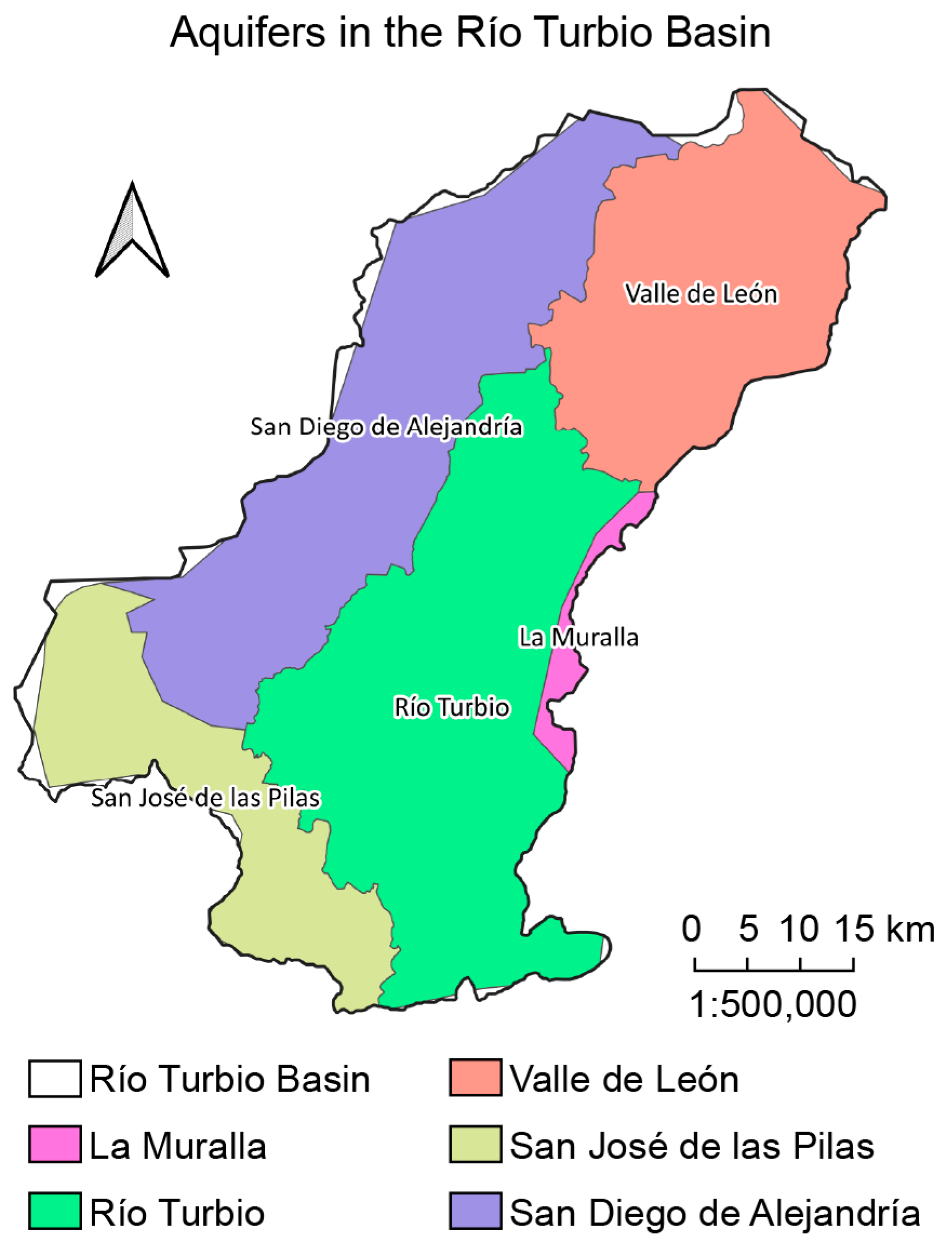
| Code | Aquifer | Recharge (R) | Committed Natural Discharge (DNC) | Groundwater Extraction Volumes (VEAS) | Average Annual Availability (DMA) |
|---|---|---|---|---|---|
| 1111 | La Muralla | 34.8 | 5.0 | 40.141518 | −10.341518 |
| 1113 | Valle de León | 124.5 | 0.0 | 186.138096 | −61.638096 |
| 1114 | Río Turbio | 110.0 | 0.0 | 164.256337 | −54.256337 |
| 1444 | San Diego de Alejandría | 36.5 | 0.0 | 46.106796 | −9.606796 |
| 1445 | San José de las Pilas | 19.8 | 6.3 | 15.066512 | −1.566512 |
Appendix B
Structure of Semi-Directed Interviews
| 1. Introduction | The semi-directed interviews conducted for this study aimed to explore the multidimensional water crisis in the Río Turbio Basin (RTB). The objective was to gain insights from key stakeholders regarding governance challenges, environmental degradation, social conflicts, and economic vulnerabilities linked to water management in the RTB. | |
| 2. Interview Format | The interviews followed a semi-structured format, allowing flexibility for participants to elaborate on key issues while ensuring consistency in data collection across different stakeholder groups. Interviews were conducted between Q4 2023 and Q3 2024 and lasted approximately 45–60 min each. | |
| 3. Stakeholder Groups | Interviewees were selected based on their expertise and involvement in water management within the RTB. The stakeholder groups included the following: |
|
| 4. Thematic Categories and Sample Questions | The interviews covered five thematic dimensions: |
|
| 5. Ethical Considerations and Confidentiality | All interviews were conducted under strict confidentiality agreements. Participants were informed of their right to anonymity, and no personally identifiable information was recorded. Consent was obtained for audio recording, and transcripts were anonymized before analysis. | |
| 6. Data Analysis Approach | Interviews were transcribed verbatim and manually coded to identify recurring themes. The qualitative analysis followed an iterative process, ensuring that emerging patterns reflected the perspectives of different stakeholder groups. |
References
- González-Leiva, F.; Ibáñez-Castillo, L.A.; Valdés, J.B.; Vázquez-Peña, M.A.; Ruiz-García, A. Pronóstico de caudales con Filtro de Kalman Discreto en el río Turbio. Tecnol. Cienc. Agua 2015, 6, 5–24. Available online: https://www.scielo.org.mx/pdf/tca/v6n4/v6n4a1.pdf (accessed on 13 February 2025).
- González Santana, O. El reto de la gestión del agua en las regiones de México ante los efectos del cambio climático: El caso de la cuenca del río Turbio. Cuad. Geogr. Rev. Colomb. Geogr. 2013, 22, 125–144. Available online: http://www.scielo.org.co/scielo.php?script=sci_arttext&pid=S0121-215X2013000200008&lng=en&tlng=es (accessed on 26 January 2025). [CrossRef]
- Orozco, I.; Martínez, A.; Ortega, V. Assessment of the Water, Environmental, Economic and Social Vulnerability of a Watershed to the Potential Effects of Climate Change and Land Use Change. Water 2020, 12, 1682. [Google Scholar] [CrossRef]
- Instituto Nacional de Ecología y Cambio Climático (INECC). Impacto del Cambio Climático en Los Recursos Hídricos de México; INECC: Ciudad de Mexico, Mexico, 2018. [Google Scholar]
- Gómez-Padilla, B.E.; Esquer-Peralta, J.; Munguía-Morales, H.E.; Esquer-Miranda, E.; García-Bedoya, D. Tanning leather environmental assessment: A case study in León, Mexico. Propues. Ambient. 2023, 1, 56–76. [Google Scholar] [CrossRef]
- Flores Casamayor, H.; Morales Martínez, J.L.; Mora-Rodríguez, J.; Delgado-Galván, X. Assessing industrial impact on water sustainability in El Bajío, Guanajuato State, Mexico. Sustainability 2021, 13, 6161. [Google Scholar] [CrossRef]
- Carrillo-Chávez, A.; Morton-Bermea, O.; González-Partida, E.; Rivas-Solorzano, H.; Oesler, G.; García-Meza, V.; Hernández, E.; Morales, P.; Cienfuegos, E. Environmental geochemistry of the Guanajuato Mining District, Mexico. Ore Geol. Rev. 2003, 23, 277–297. [Google Scholar] [CrossRef]
- Ocampo-Astudillo, A.; Garrido-Hoyos, S.E.; Salcedo-Sánchez, E.R.; Martínez-Morales, M. Alteration of groundwater hydrochemistry due to its intensive extraction in urban areas from Mexico. In Water Availability and Management in Mexico; Springer: Cham, Switzerland, 2020; pp. 77–97. [Google Scholar]
- Espejo, R.P. Water Pollution from Agriculture: Policy Challenges in a Case Study of Guanajuato. In Water Resources in Mexico: Scarcity, Degradation, Stress, Conflicts, Management, and Policy; Springer: Berlin/Heidelberg, Germany, 2011; pp. 435–448. [Google Scholar]
- Comisión Nacional del Agua (CONAGUA). Estadísticas del Agua en México; CONAGUA: Ciudad de Mexico, Mexico, 2020. [Google Scholar]
- Sánchez-Triana, E.; Ortolano, L. Environmental impact assessment in Mexico: An analysis from a “consolidating democracy” perspective. Environ. Impact Assess. Rev. 2005, 25, 439–463. [Google Scholar]
- Romero Lankao, P.; Qin, H. Conceptualizing urban vulnerability to global climate and environmental change: Insights from a study of climate hazards in Mexican cities. Curr. Opin. Environ. Sustain. 2011, 3, 142–149. [Google Scholar] [CrossRef]
- Pineda Capacho, P.A.; Martínez Bárcemas, A.; Aguilera Rico, H.A.; Orozco Medina, I. Evaluación del impacto de la urbanización y el cambio climático sobre la recarga de aguas subterráneas y el balance hidrológico en la subcuenca del río Turbio, Guanajuato. Acta Univ. 2022, 32, e3485. [Google Scholar] [CrossRef]
- Global Water Partnership (GWP). Integrated Water Resources Management; TAC Background Papers No. 4; Global Water Partnership: Stockholm, Sweden, 2000; Available online: https://www.gwp.org (accessed on 13 February 2025).
- Mitchell, B. Integrated water resource management, institutional arrangements, and land-use planning. Environ. Plan. A 2005, 37, 1335–1352. [Google Scholar] [CrossRef]
- Biswas, A.K. Integrated water resources management: A reassessment. Water Int. 2004, 29, 248–256. [Google Scholar] [CrossRef]
- Armas Vargas, F.; Nava, L.F.; Gómez Reyes, E.; Olea-Olea, S.; Rojas Serna, C.; Sandoval Solís, S.; Meza-Rodríguez, D. Water and environmental resources: A multi-criteria assessment of management approaches. Water 2023, 15, 2991. [Google Scholar] [CrossRef]
- Nava, L.F. La desafiante gestión integrada de los recursos hídricos en México: Elaboración de recomendaciones políticas. In Las Ciencias en Los Estudios del Agua: Viejos Desafíos Sociales y Nuevos Retosen; Ramirez, R., Pablo, J.J., Santana, O.G., Eds.; Guadalajara Editorial Universitaria: Guadalajara, Mexico, 2018; pp. 26–42. [Google Scholar]
- Domínguez Serrano, J. El acceso al agua y saneamiento: Un problema de capacidad institucional local. Análisis en el estado de Veracruz. Gest. Política Pública 2010, 19, 311–350. Available online: http://www.scielo.org.mx/scielo.php?script=sci_arttext&pid=S1405-10792010000200004&lng=es&tlng= (accessed on 13 February 2025).
- Alpuche Álvarez, Y.A.; Nava, L.F.; Carpio Candelero, M.A.; Contreras Chablé, D.I. Vinculando ciencia y política pública. La Ley de Aguas Nacionales bajo la perspectiva sistémica y de servicios ecosistémicos. Gest. Política Pública 2021, 30, 133–170. [Google Scholar] [CrossRef]
- Nava, L.F.; Medrano-Pérez, O.R.; Cáñez Cota, A.; Torres Bernardino, L. La seguridad hídrica en México: El derecho humano al agua. Una oportunidad. In Revista IAPEM, 2019, Temas de Administración Pública—Public Administration Topics, 103; Instituto de Administración Pública del Estado de México, Asociación Civil (AC): Tlalnepantla, Mexico, 2019; pp. 71–88. Available online: https://t.ly/bjBu0 (accessed on 13 February 2025).
- Wilder, M.; Martínez Austria, P.F.; Hernández Romero, P.; Cruz Ayala, M.B. The human right to water in Mexico: Challenges and opportunities. Water Altern. 2020, 13, 28–48. [Google Scholar]
- Tagle-Zamora, D.; Caldera-Ortega, A.R. Regulation, public water management and market environmentalism in Mexico: An analysis from political projects. Tecnol. Cienc. Agua 2019, 10, 1–34. [Google Scholar] [CrossRef]
- Varady, R.G.; Albrecht, T.R.; Staddon, C.; Gerlak, A.K.; Zuniga-Teran, A.A.; Bogardi, J.J.; Gupta, J.; Nandalal, K.D.W.; Salamé, L.; van Nooijen, R.R.P.; et al. The Water Security Discourse and Its Main Actors. In Handbook of Water Resources Management: Discourses, Concepts and Examples; Bogardi, J.J., Gupta, J., Nandalal, K.D.W., Salamé, L., van Nooijen, R.R.P., Bhaduri, A., Eds.; Springer: Cham, Switzerland, 2021. [Google Scholar] [CrossRef]
- Mould, S.A.; Fryirs, K.A.; Howitt, R. The importance of relational values in river management: Understanding enablers and barriers for effective participation. Ecol. Soc. 2020, 25, 17. [Google Scholar] [CrossRef]
- Anisfeld, S.C. Water Management: Prioritizing Justice and Sustainability; Island Press: Washington, DC, USA, 2024. [Google Scholar]
- Yang, L.E. Managing water-related vulnerability and resilience of urban communities in the Pearl River Delta. In Climate Change, Security Risks, and Violent Conflicts; Hamburg University Press: Hamburg, Germany, 2020; p. 121. [Google Scholar]
- Nandineni, R.D.; Dash, S.P. Capacity Building in Water Resource Management in Developing Countries. In Clean Water and Sanitation; Springer International Publishing: Cham, Switzerland, 2022; pp. 49–61. [Google Scholar]
- Ofori, A.D.; Mdee, A. Integrated water resource management. In Clean Water and Sanitation; Springer International Publishing: Cham, Switzerland, 2022; pp. 344–357. [Google Scholar]
- Gomes, S.L. Interventions to Strengthen Institutional Capacity for Peri-Urban Water Management in South Asia. In Water Security, Conflict and Cooperation in Peri-Urban South Asia: Flows across Boundaries; Springer: Cham, Switzerland, 2022; pp. 147–169. [Google Scholar]
- Benson, D.; Gain, A.K.; Giupponi, C. Moving beyond water centricity? Conceptualizing integrated water resources management for implementing sustainable development goals. Sustain. Sci. 2020, 15, 671–681. [Google Scholar] [CrossRef]
- Yang, S.; Zhao, W.; Liu, Y.; Cherubini, F.; Fu, B.; Pereira, P. Prioritizing sustainable development goals and linking them to ecosystem services: A global expert’s knowledge evaluation. Geogr. Sustain. 2020, 1, 321–330. [Google Scholar] [CrossRef]
- Eisenmenger, N.; Pichler, M.; Krenmayr, N.; Noll, D.; Plank, B.; Schalmann, E.; Wandl, M.-T.; Gingrich, S. The Sustainable Development Goals prioritize economic growth over sustainable resource use: A critical reflection on the SDGs from a socio-ecological perspective. Sustain. Sci. 2020, 15, 1101–1110. [Google Scholar] [CrossRef]
- lores Casamayor, H.; Morales Martínez, J.L.; Tagle-Zamora, D.; Delgado Galván, X.V. El modelo económico y su influencia en el desarrollo sustentable de cinco municipios de Guanajuato. Acta Univ. 2020, 30, 1–26. [Google Scholar] [CrossRef]
- Tinoco, C.; Julio, N.; Meirelles, B.; Pineda, R.; Figueroa, R.; Urrutia, R.; Parra, Ó. Water resources management in Mexico, Chile and Brazil: Comparative analysis of their progress on SDG 6.5. 1 and the role of governance. Sustainability 2022, 14, 5814. [Google Scholar] [CrossRef]
- Kittikhoun, A.; Schmeier, S. (Eds.) River Basin Organizations in Water Diplomacy; Routledge: London, UK, 2020. [Google Scholar]
- Shemer, H.; Wald, S.; Semiat, R. Challenges and solutions for global water scarcity. Membranes 2023, 13, 612. [Google Scholar] [CrossRef]
- Momen, M.N. Multi-stakeholder partnerships in public policy. In Partnerships for the Goals; Springer International Publishing: Cham, Switzerland, 2021; pp. 768–776. [Google Scholar]
- Hartley, J. What is a case study. In Essential Guide to Qualitative Methods in Organizational Research; SAGE Publications Inc.: Thousand Oaks, CA, USA, 2004; p. 323. [Google Scholar]
- Rashid, Y.; Rashid, A.; Warraich, M.A.; Sabir, S.S.; Waseem, A. Case Study Method: A Step-by-Step Guide for Business Researchers. Int. J. Qual. Methods 2019, 18, 1609406919862424. [Google Scholar] [CrossRef]
- Harrison, H.; Birks, M.; Franklin, R.; Mills, J. Case study research: Foundations and methodological orientations. Forum Qual. Sozialforsch. Forum Qual. Soc. Res. 2017, 18, 2655. [Google Scholar] [CrossRef]
- Gerlak, A.K.; House-Peters, L.; Varady, R.G.; Albrecht, T.; Zúñiga-Terán, A.; de Grenade, R.R.; Cook, C.; Scott, C.A. Water security: A review of place-based research. Environ. Sci. Policy 2018, 82, 79–89. [Google Scholar] [CrossRef]
- Wehn, U.; Montalvo, C. Exploring the dynamics of water innovation: Foundations for water innovation studies. J. Clean. Prod. 2018, 171, S1–S19. [Google Scholar] [CrossRef]
- Pahl-Wostl, C. Transitions towards adaptive management of water facing climate and global change. Water Resour. Manag. 2007, 21, 49–62. [Google Scholar] [CrossRef]
- Tagle-Zamora, D. Presa El Zapotillo: Una discusión de su pertinencia para León, Guanajuato, a una década del conflicto por el agua. Estud. Demogr. Urbanos 2003, 38, 247–282. [Google Scholar] [CrossRef]
- Scanlan, C.L. Preparing for the Unanticipated: Challenges in Conducting Semi-Structured, In-Depth Interviews; SAGE Publications Limited: London, UK, 2020; pp. 67–80. [Google Scholar]
- Naz, N.; Gulab, F.; Aslam, M. Development of qualitative semi-structured interview guide for case study research. Compet. Soc. Sci. Res. J. 2022, 3, 42–52. [Google Scholar]
- Osborne, N.; Grant-Smith, D. In-depth interviewing. In Methods in Urban Analysis; Springer: Singapore, 2021; pp. 105–125. [Google Scholar]
- Tagle-Zamora, D.; Caldera-Ortega, A.R. Agua, conflictos redistributivos y gobernabilidad: El caso de León, Guanajuato. In Estado y Ciudadanías del Agua: ¿Cómo Significar las Nuevas Relaciones? UAM-C y el Programa de Estudios Sobre la Ciudad UNAM: Ciudad de Mexico, Mexico, 2014; p. 175. [Google Scholar]
- Tagle-Zamora, D.; Caldera-Ortega, A.R.; Rodríguez González, J.A. Complejidad ambiental en el Bajío mexicano: Implicaciones del proyecto civilizatorio vinculado al crecimiento económico. Reg. Soc. 2017, 29, 193–221. [Google Scholar] [CrossRef]
- Tagle-Zamora, D.; Caldera-Ortega, A.R.; Villalpando Vázquez, V. Negociaciones fallidas en la cuenca del río Turbio 1987–2014: El caso de la industria curtidora y el deterioro del bien común. Argum. Mex. DF 2015, 28, 59–77. [Google Scholar]
- Gupta, J.; Pahl-Wostl, C.; Zondervan, R. ‘Glocal’water governance: A multi-level challenge in the anthropocene. Curr. Opin. Environ. Sustain. 2013, 5, 573–580. [Google Scholar] [CrossRef]
- Pahl-Wostl, C. A conceptual framework for analysing adaptive capacity and multi-level learning processes in resource governance regimes. Glob. Environ. Change 2009, 19, 354–365. [Google Scholar] [CrossRef]
- Pacheco-Vega, R. Governing Urban Water Conflict through Watershed Councils—A Public Policy Analysis Approach and Critique. Water 2020, 12, 1849. [Google Scholar] [CrossRef]
- Howell, C.L.; Cortado, A.P.; Ünver, O. Stakeholder Engagement and Perceptions on Water Governance and Water Management in Azerbaijan. Water 2023, 15, 2201. [Google Scholar] [CrossRef]
- Teweldebrihan, M.D.; Dinka, M.O. Sustainable Water Management Practices in Agriculture: The Case of East Africa. Encyclopedia 2025, 5, 7. [Google Scholar] [CrossRef]
- Axon, S. Unveiling Understandings of the Rio Declaration’s Sustainability Principles: A Case of Alternative Concepts, Misaligned (Dis)Connections, and Terminological Evolution. Sustainability 2024, 16, 2600. [Google Scholar] [CrossRef]
- Nava, L.F.; Torres Bernardino, L.; Orozco, I. Crisis Water Management in Mexico. In The Palgrave Encyclopedia of Sustainable Resources and Ecosystem Resilience; Brears, R., Ed.; Palgrave Macmillan: Cham, Switzerland, 2024. [Google Scholar] [CrossRef]
- Oswald Spring, Ú. The water, energy, food and biodiversity Nexus: New security issues in the case of Mexico. In Addressing Global Environmental Challenges from a Peace Ecology Perspective; Springer: Cham, Switzerland, 2016; pp. 113–144. [Google Scholar]
- Maganda, C. The Politics of Regional Water Management: The Case of Guanajuato, Mexico. J. Environ. Dev. 2003, 12, 389–413. [Google Scholar] [CrossRef]
- Cosens, B.A.; Stow, C.A. Five. Resilience and water governance addressing fragmentation and uncertainty in water allocation and water quality law. In Social-Ecological Resilience and Law; Columbia University Press: New York, NY, USA, 2014; pp. 142–175. [Google Scholar]
- Romano, O.; Akhmouch, A. Water Governance in Cities: Current Trends and Future Challenges. Water 2019, 11, 500. [Google Scholar] [CrossRef]
- Mourad, K.A. A Water Compact for Sustainable Water Management. Sustainability 2020, 12, 7339. [Google Scholar] [CrossRef]

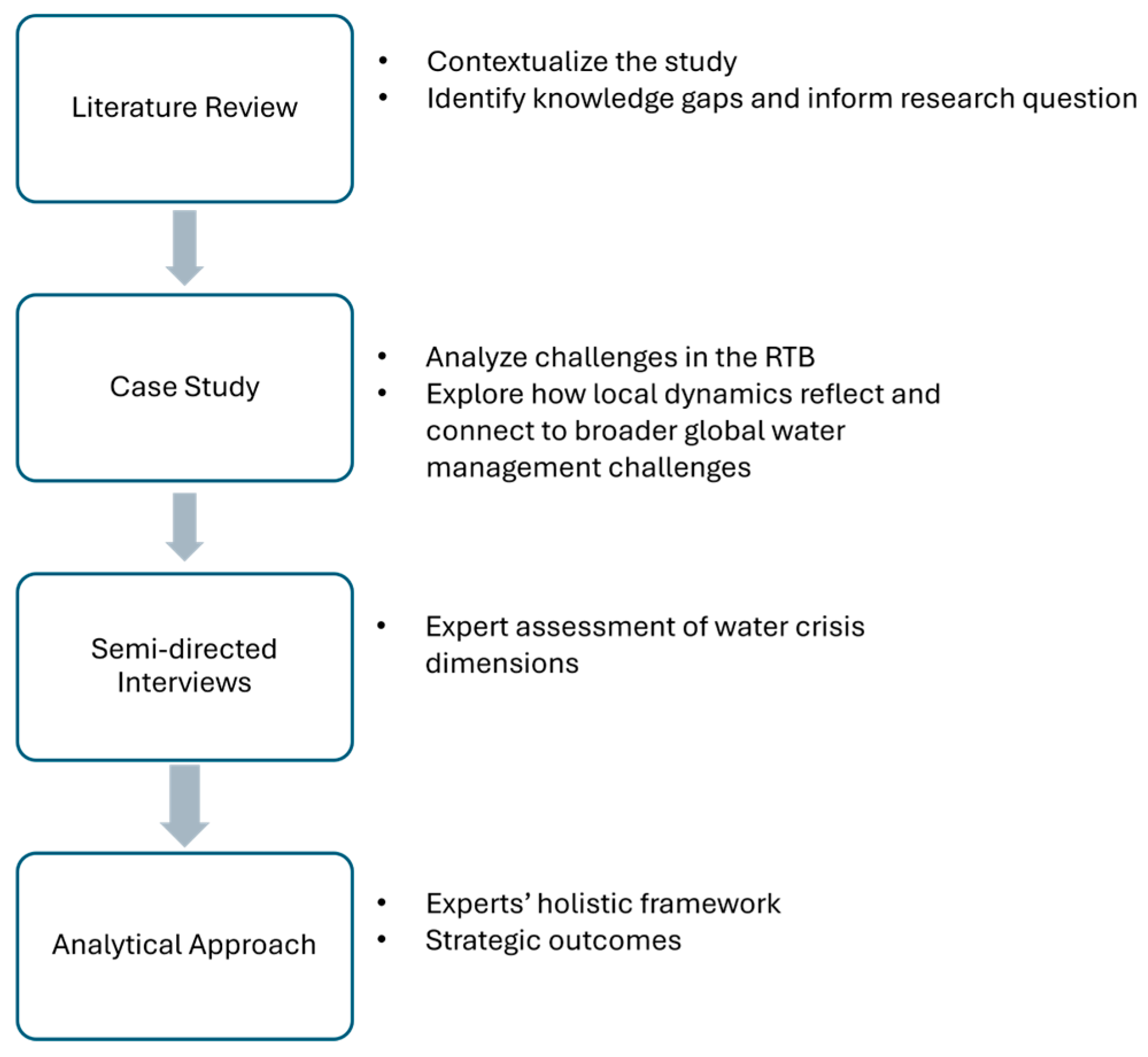
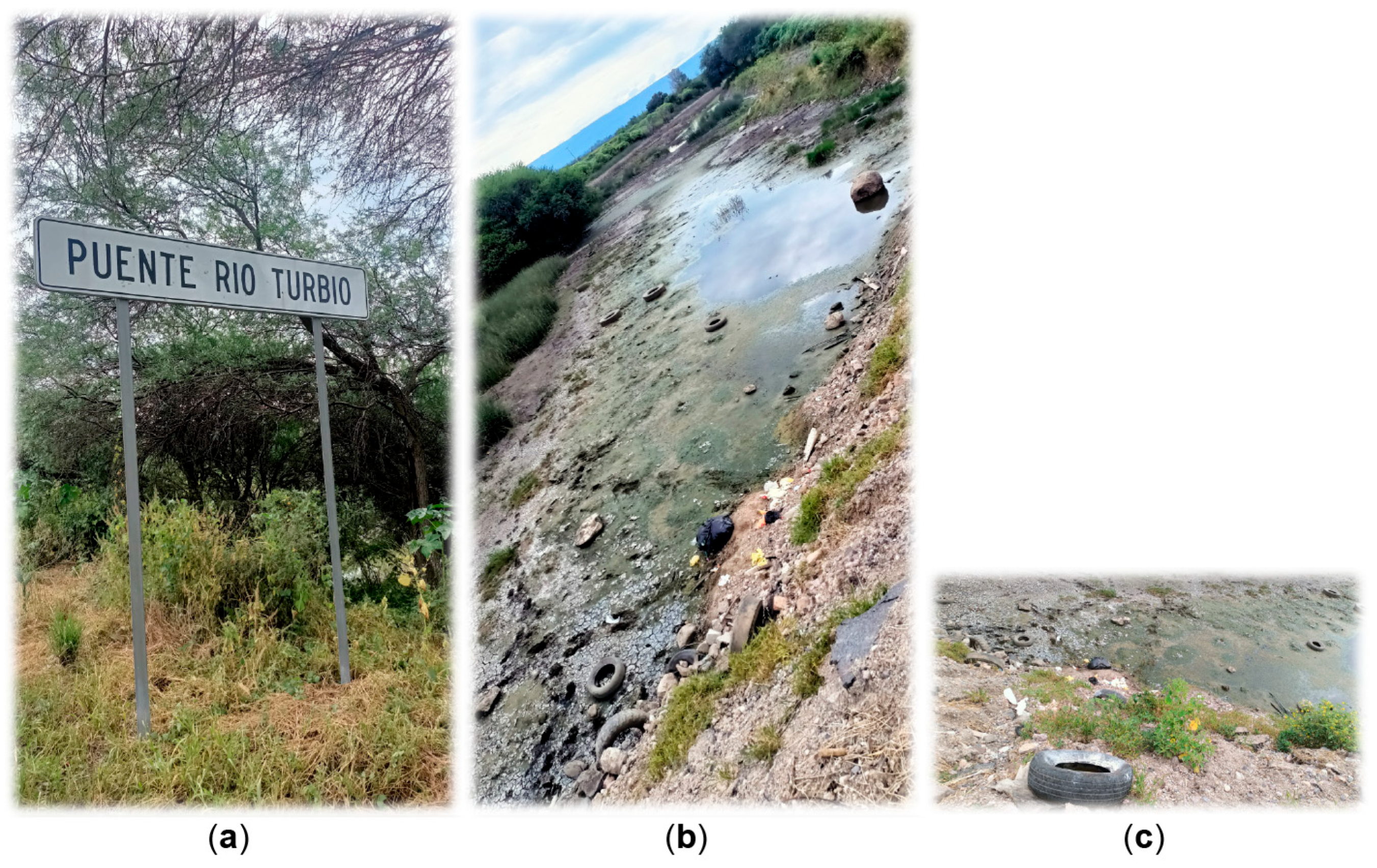
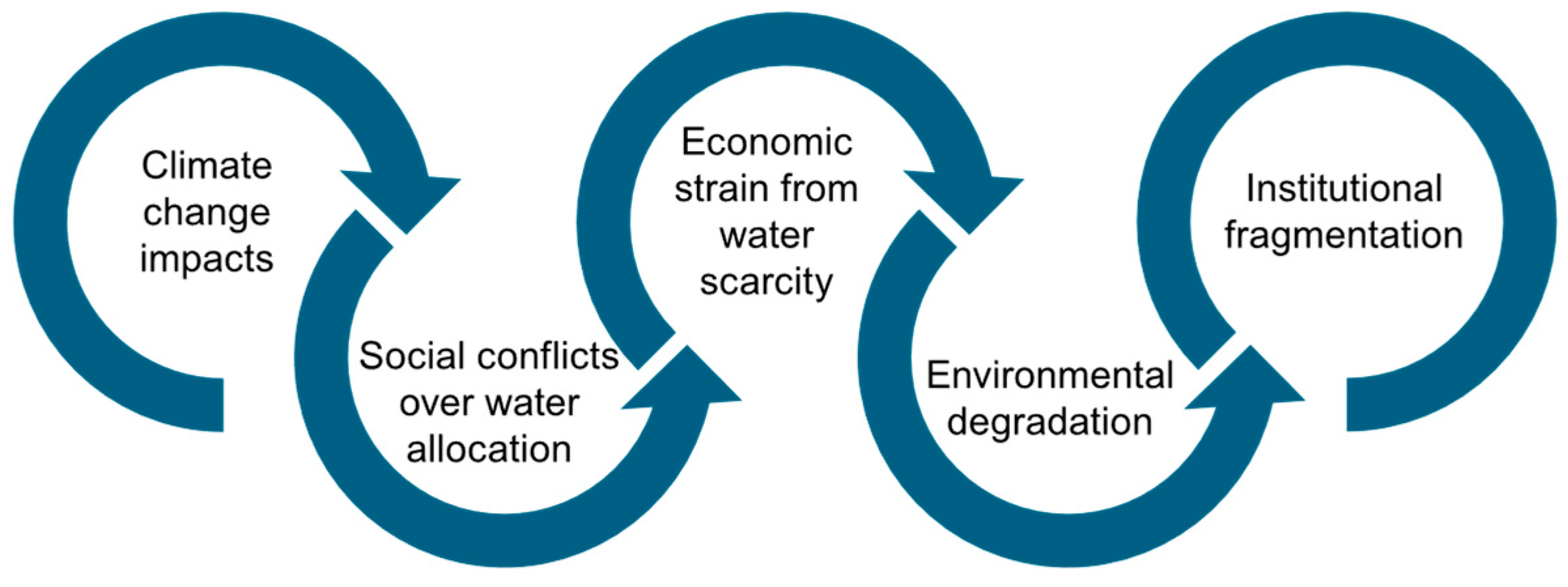
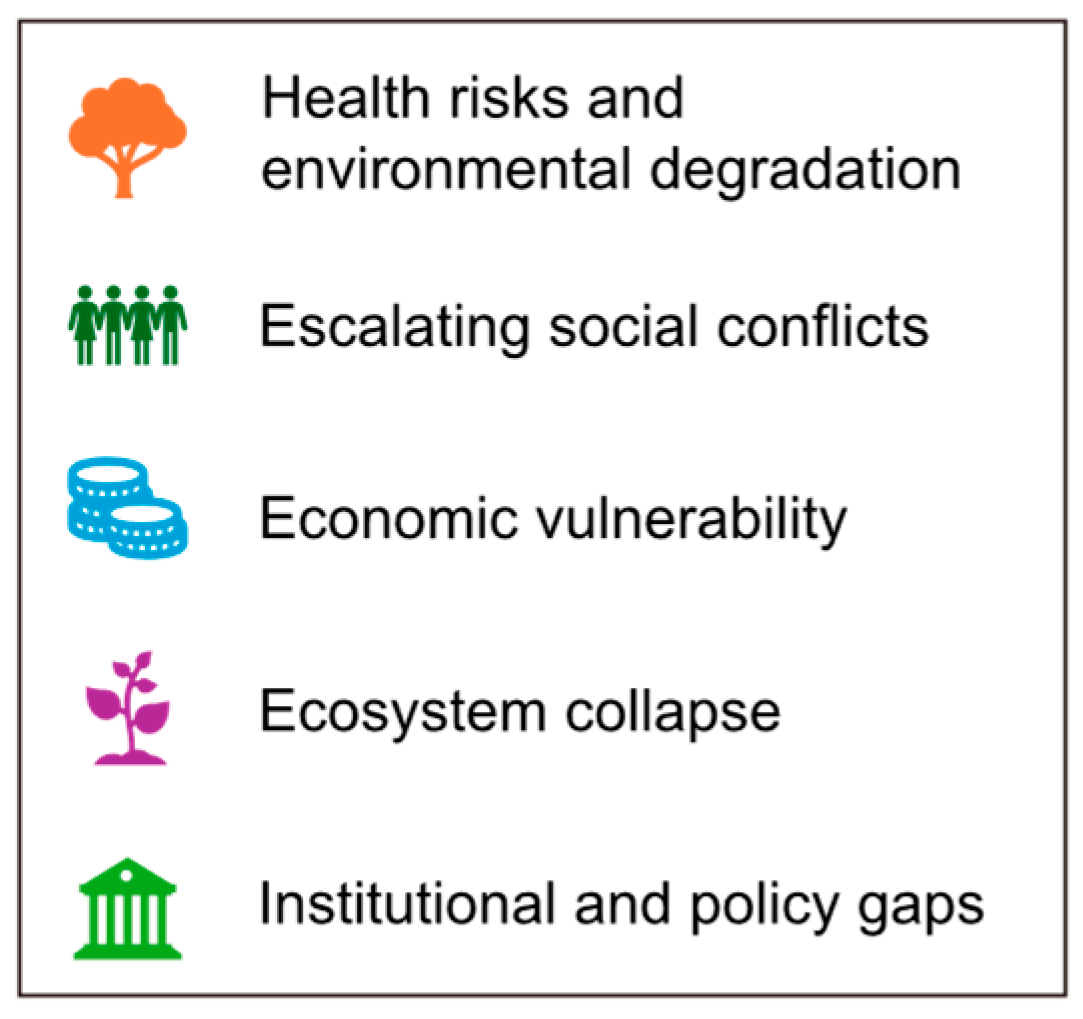
Disclaimer/Publisher’s Note: The statements, opinions and data contained in all publications are solely those of the individual author(s) and contributor(s) and not of MDPI and/or the editor(s). MDPI and/or the editor(s) disclaim responsibility for any injury to people or property resulting from any ideas, methods, instructions or products referred to in the content. |
© 2025 by the authors. Licensee MDPI, Basel, Switzerland. This article is an open access article distributed under the terms and conditions of the Creative Commons Attribution (CC BY) license (https://creativecommons.org/licenses/by/4.0/).
Share and Cite
Nava, L.F.; Perera-Burgos, J.A. Key Challenges and Potential Opportunities in Water Management Crises: The Case of the Rio Turbio Basin in Mexico. Water 2025, 17, 550. https://doi.org/10.3390/w17040550
Nava LF, Perera-Burgos JA. Key Challenges and Potential Opportunities in Water Management Crises: The Case of the Rio Turbio Basin in Mexico. Water. 2025; 17(4):550. https://doi.org/10.3390/w17040550
Chicago/Turabian StyleNava, Luzma Fabiola, and Jorge Adrián Perera-Burgos. 2025. "Key Challenges and Potential Opportunities in Water Management Crises: The Case of the Rio Turbio Basin in Mexico" Water 17, no. 4: 550. https://doi.org/10.3390/w17040550
APA StyleNava, L. F., & Perera-Burgos, J. A. (2025). Key Challenges and Potential Opportunities in Water Management Crises: The Case of the Rio Turbio Basin in Mexico. Water, 17(4), 550. https://doi.org/10.3390/w17040550







